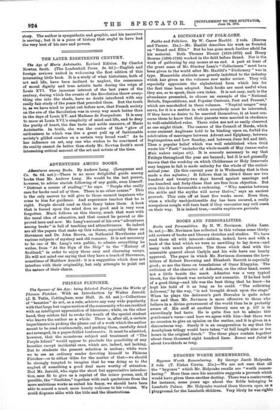A DICTIONARY OF FOLK-LORE.
Faiths and Folk-lore. By W. Carew Hazlitt. 2 vols. (Reeves and Turner. 21s.)—Mr. Hazlitt describes his work as founded on " Brand and Ellis." But he has gone much further afield for his material. Both Thomas Blount (1618-1679) and Henry Bourne (1696-.1733) worked in the field before Brand. Nor is the work of gathering by any means at an end. A part at least of the great mass of Mr. Stuckey Lean's " Collectanea " must have been given to the world after Mr. Hazlitt's " Dictionary " was in type. Meanwhile students are greatly indebted to the industry which has given us the volumes now under review. They will especially appreciate the alphabetical form which has for the first time been adopted. Such books are most useful when they are, so to speak, their own index. It is not easy, such is the abundance presented, to choose an example of the " National Beliefs, Superstitions, and Popular Customs, Past and Present," which are marshalled in these volumes. "Nuptial usages" may serve, for it is a matter in which everybody must be interested. If they have no desire to be married themselves, it at least con- cerns them to know that their parents were married in obedience to well-established rules. These rules are not so easily observed as one might think. The canons of the Council of Herda, which some eminent Anglicans hold to be binding upon us, forbid the celebration of marriages between Advent and Epiphany, between Septuagesima and Low Sunday, and between June 3rd and 24th. Then a popular belief which was well established when Ovid wrote his " Fasti" excludes the whole month of May (mense malas Maio nubere vulgus ait). It is scarcely necessary to say that Fridays throughout the year are banned; but it is not generally known that the weekday on which Childermas or Holy Innocents may happen to fall is made unlucky for the whole of the ecclesi- astical year. (In this current year it is Wednesday that is thus made a dies nefastus.) It follows that in 1904-5 there are two hundred and twenty-two days barred against marriage and one hundred and forty-three that are free from objection. But even this is too favourable a reckoning. " Who marries between the sickle and the scythe will never thrive," says an ancient proverb. This cuts off at least five weeks more. Even then, when a wholly unobjectionable day has been secured, a really scrupulous couple will turn back if they encounter any evil omen on their way. It is indeed true,—muita nuptiarum pericula.


















































 Previous page
Previous page